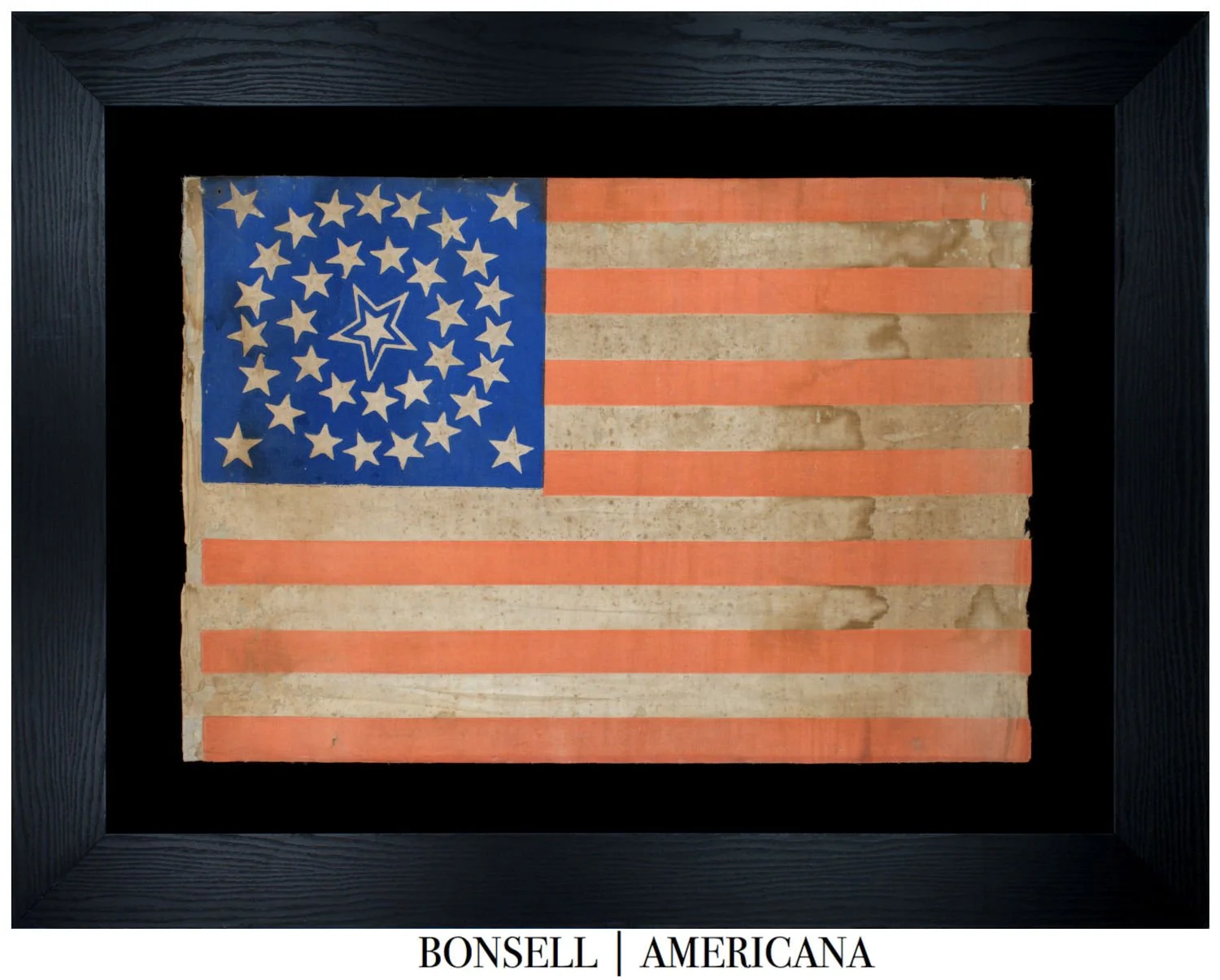38 Star Antique Flag with a GAR Overprint and Tightly Packed Stars | Colorado Statehood | Circa 1876-1889
38 Star Antique Flag with a GAR Overprint and Tightly Packed Stars | Colorado Statehood | Circa 1876-1889
Frame Size (H x L): 22” x 17”
Flag Size (H x L): 14” x 9”
Offered is a fantastic thirty-eight star parade flag. Parade flags are small scale flags that were meant to be used for a short time, typically at parades and rallies. A subset of parade flags are overprinted and include some kind of printing, this example being a Grand Army of the Republic (“GAR”) parade flag. The GAR was a fraternal organization for the veterans of the Union Army, Union Navy, and Marines who served in the Civil War. GAR members provided support to one another and also remembered those who had fallen in battle. It was founded in 1866, peaked in 1890 with almost 500,000 members, and dissolved in 1956 when its last member died. This particular GAR flag was for the Byron D. Smith Post.
The stars are arranged somewhat haphazardly across the canton, and are canted in various different directions. The stars are folksy in their makeup, many of which whimsically skinny and interconnected with one another.
The thirty-eight star flag represents the inclusion of Colorado to the Union. Colorado was admitted on August 1st, 1876 and this flag became official on July 4th, 1877. Presidents Hayes, Garfield, Arthur, Cleveland, and Harrison all served under this flag. Colorado became known as the “Centennial State,” a result of becoming official just twenty-eight days after the centennial. The official star count for US flags in 1876 was the thirty-seven star flag. However, it was common for flag makers to produce anticipatory flags in advance of their official date, making the thirty-eight star flag—and for historical reasons, the thirteen star flag—the most common flags flown during the centennial celebrations of 1876.
The nation’s centennial in 1876 inspired patriotism across the county and reunited its citizens. Cities of all sizes hosted parades and celebrations, and buildings and homes were canvased in red, white, and blue with flags being the primary symbol of national pride. The most notable celebration was the Centennial International Exposition in Philadelphia. In just six months, the Exhibition hosted nearly 10 million visitors, and included many extraordinary exhibits, including the introduction of the Corliss Steam Engine and Alexander Graham Bell’s telephone.
The thirty-eight star flag was official until July 4th, 1890, the time at which the forty-three star flag became official and began to represent the inclusion of North Dakota, South Dakota, Montana, Washington, and Idaho to the Union.
Conservation Process: This flag was hand sewn to cotton fabric, and both were hand sewn to a mounting board. To prevent the black dye in the cotton fabric from seeping into the flag, it was first washed in a standard wash and then in a dye setting wash. The flag is positioned behind Conservation Clear Acrylic (standard) or behind Optium Museum Acrylic (per request).
Frame: The decorated antique frame dates to between around 1870-1880.
Condition Report: The canton and some of the stripes are faded. The flag has some small holes, but otherwise is in very good condition. Many collectors prefer flags that show their use and age.
Collectability Level: The Great – Perfect for Rising Collectors
Date of Origin: 1876-1889
Number of Stars: 38
Associated War: The Indian Wars (1860-1890)
Associated State: Colorado







